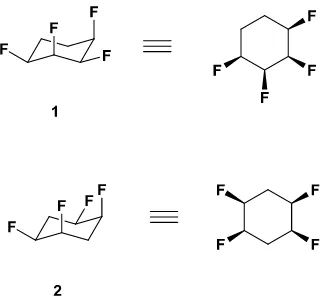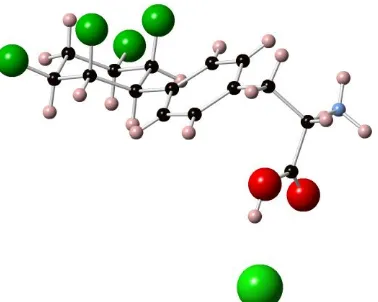1
Fluorine containing amino acids: Synthesis and peptide coupling of amino
acids containing the all-
cis
tetrafluorocyclohexyl motif
Mohammed Salah Ayoup,†,‡ David B. Cordes,† Alexandra M. Z. Slawin,† and David O’Hagan†*
†
School of Chemistry, University of St Andrews, North Haugh, St Andrews, KY16 9ST, UK.
‡Department of Chemistry, Faculty of Science, P.B 426 Ibrahimia, Alexandria University, Egypt.
Corresponding author e.mail do1@st-andrews.ac.uk
Abstract: A synthesis of two (S)-phenylalanine derivatives is described which have the
all-cis, 2,3,5,6-tetrafluorocyclohexyl motif attached to the aromatic ring at the meta and para
positions; the para substituted isomer is elaborated into illustrative dipeptides via the free amine and carboxylate respectively demonstrating its utility as a novel amino acid for peptide synthesis and offering a vehicle for incorporation of this unique and facially polarized ring system into bioactive compounds.
Our laboratory has developed an interest in preparing selectively fluorinated cyclohexane rings,
with no more than one fluorine on each carbon and where at least two of the C-F bond lie
1,3-diaxial to each other.1 Such a diaxial arrangement generates two parallel C-F bonds, and as a
consequence of the high polarity of this bond, the arrangement differentially polarises the two
faces of the cyclohexane. This creates a large molecular dipole moment and offers unique polar
hydrophobic properties to the motif. In order to hold this conformation in the ground state it has
been necessary to prepare cyclohexanes with at least four C-F bonds and all with the same ‘up’
stereochemistry. This was first illustrated by the synthesis of tetrafluorocyclohexanes 11a and 2.1b
for these compounds there are always four fluorines on one face of the ring, with two C-F bonds
2
Fig. 1 All-cis tetrafluorocyclohexane isomers 1 and 2.
Of note is the high molecular dipole moments of 1 and 2 (4.9 D and 5.2D respectively)1a,1b. Crystallography reveals that these molecules have a tendency to stack one on top of another
consistent with electrostatic compensation in the solid state. In solution the axial hydrogens on
the non-fluorous face of the rings display anisotropic shifts by 1H-NMR when the solvent is
changed from dichloromethane to toluene, consistent with the aromatic solvent associating with
the electropositive face of the cyclohexane. The interesting properties of these ring systems have
challenged us to find relatively accessible building blocks such that they can be incorporated as a
substituent in a building block fir utility in a diversity of research programmes. To that end we
recently described a method for the preparative synthesis of all-cis
3-phenyl-1,2,4,5-tetrafluorocyclohexane 3.1c,1d This compound is amenable to a range of electrophilic aromatic substitution reactions, and some of these transformations have recently been described.1c
Selectively fluorinated amino acids have been the focus of much attention2 and we were
attracted by the prospect of placing this motif into an amino acid as a building block for its
inclusion into designer peptides. In this Communication we report the synthesis of the new
amino acids (S)-11 and (S)-12 carrying the all-cis 1,2,4,5,-tetrafluorocyclohexane ring system.
One of these (S)-phenylalanine derivatives 11 is differentially protected for regioselective
elaboration at the carboxy and N-termini to generate dipetides with (S)-phenylalanine, and also
an amide to isopenicillin-N is also prepared.
Our approach to the amino acids came from an initial iodination reaction of 3 in a periodic acid
[image:2.595.210.370.72.221.2]3
Scheme 1 Products of the iodination of 3. i. HIO4.2H2O (50 %), AcOH,H2SO4, I2, H2O, 70 °C 24 h, 92 %.
Chromatography readily removed the minor ortho isomer 4 and the diiodo product 7 respectively from the major meta/para products 5/6, however these latter two isomers were proved inseparable. Iodides 5 and 6 were taken as a mixture (ratio 1:3 respectively) and were subjected to Jackson’s methodology4-6 for amino acid synthesis via Zn homoenolate coupling
with the protected (R)-iodoalanine 85,6 as illustrated in Scheme 2. This resulted in an excellent conversion to the fully protected amino acid isomers 9 and 10, which were readily separated
from each other by chromatography. When treated separately, deprotection7 of the isomers gave
the individual free amino acids (S)-11 and (S)-12. A crystal of (S)-11 proved amenable to X-ray
analysis and the structure is shown in Figure 2. The structure has the expected 1,3-diaxial
4
Scheme 2 Synthesis of amino acids 11 and 12: i. Zn, I2, DMF, 8 ,Pd2(dba)3, SPhos, 85 %; ii. 6M HCl in
5
Figure 2 X-Ray structure of amino acid (S)-11 as a HCl salt. (Structure data deposited at the Cambridge
Crystallographic Data Centre, CCDC No = 1057152).
In order to explore further elaboration of a tetrafluorocyclohexyl amino acid, peptide coupling of
the hydrochloride salt of (S)-11 via the carboxylate, was explored. Thus N-Boc protection using
di-t-butyldicarbonate in THF gave N-Boc 138 which could be coupled with L-phenylalanine-OMe9 to generate dipeptide 14 in good yield.
Scheme 3 C-Terminal coupling to generate dipeptide 14 and 15 i. NaHCO3, THF/H2O (1:1), (Boc)2O, rt,
overnight 93 %; ii. EDCI, HOBt, NMM, DMF, rt, overnight 87 %; iii. TFA, DCM (1:4), rt, 4h, 94 %.
N-Boc deprotection with trifluoroacetic acid10 resulted in the dipeptide methyl ester 15 as its
trifluoroacetate salt. This sequence is summarized in Scheme 3.
Complementary N-terminal coupling was achieved by selective deprotection11,12 of amino acid
10 as illustrated in Scheme 4. Treatment of 10 with 4 M HCl in ethyl acetate triggered N-Boc deprotection to afford the methyl ester amine hydrochloride salt 16 in quantitative yield. This intermediate was then coupled with either N-Boc-L-Phe-OH9 or N-Fmoc L-Phe-OH13 to
6
19a as its trifluoroacetate salt, or Fmoc deprotection of 18 with 10 % diethylamine 14 in DMF or (20 % v/v ) piperidine 15 in DMF to afforded the free NH2 dipeptide of 19b.
Scheme 4: N-terminal coupling of 16 to generate dipeptide 19; i. 4 M HCl, EtOAc (1:1), rt, overnight,
100%. ; ii. HOBt, HBTU, NMM, 6h, rt, 81 %; iii. EDCI, HOBt, DMF, DIPEA, rt, overnight, 92 %; iv. 17
TFA, DCM (1:4), rt, 4h, 89 %; v. 18 DEA, DMF, rt, 2h, 94 %, or piperidine in DMF (20% v/v), rt, 2 h,
97%.
To illustrate a level of elaboration of this amino acid moiety, a penicillin derivative was prepared
as illustrated in Scheme 5. Thus coupling9 of N-Boc amino acid 13 with 6-aminopenicillinic acid
(APA) benzyl ester 2016, gave penicillin dipeptide 21 which could be partially deprotected (4 M
HCl in dioxane)17 to give the novel amino acid acylated penicillin 22 as its hydrochloride salt.
Scheme 5 Preparation of N-acylated penicillin derivatives 21 and 22. i. EDCI, HOBt, DMF, NMM, rt,
overnight, 81 %; ii. 4 M HCl, 1,4-Dioxane (1:1), 1 h, 83%.
The tetrafluorocyclohexyl moiety is resistant to acidic conditions and transformations using
trifluoroacetic acid and concentrated mineral acid are compatible with the ring system. The ring
7
to mediate aqueous base hydrolysis of the ester moiety of 14 resulted in defluorination and complex product mixtures. Thus elaborations of protecting groups under those conditions are
limiting. In conclusion, we have demonstrated the conversion of the
tetrafluorophenylcyclohexane 3 into the amino acids 11 and 12 using Jackson’s organozinc protocol. These are elaborated derivatives of L-phenylalanine, and present an unexplored polar
hydrophobic moiety in an amino acid, amenable to inclusion in peptides. The amino acids were
coupled to (S)-phenylalanine through both its C and N terminus, and one was coupled to
isopenicillin-N to demonstrate an elaboration to a relevant bioactive compound class. The
tetrafluorocyclohexane moiety is compatible with acid mediated deprotection strategies, and
organic bases, however the ring system is incompatible with aqueous base.
Acknowledgments: One of us (MA) thanks the Egyptian Government for a Scholarship and also we thank Professor Laila Fathy of the University of Alexandria, Egypt for her support.
DO’H thanks the Royal Society for a Royal Society Wolfson Research Merit Award.
References
1. (a) A. J. Durie, A. M. Z. Slawin, T. Lebl, P. Kirsch, D. O’Hagan, Chem Commun., 2011,
47, 8265. (b) A. J. Durie, A. M. Z. Slawin, T. Lebl, P. Kirsch, D. O’Hagan, Chem. Commun., 2012, 48, 9643. (c) A. J. Durie, T. Fujiwara, N. Al-Maharik, A. M. Z. Slawin,
D. O’Hagan, J. Org. Chem., 2014, 79, 8228. (d) A. J. Durie, T. Fujiwara, R. Cormanich,
M. Bühl, A. M. Z. Slawin, D. O’Hagan, Chem. Eur. J., 2014, 20, 6259.
2. (a) V. Asante, J. Mortier, G. Wolber, B. Koksch, Amino Acids, 2014, 46, 2733. (b) L.
Hunter, S. Butler, S. B. Ludbrock, Org. Biol. Chem., 2012, 10, 8911. (c) X-L. Qiu, F-L.
Qing, Eur. J. Org. Chem., 2011, 3261. (d) Y-L. Liu, T-D. Shi, F. Zhou, X-L. Zhao, X.
Wang, J. Zhou, Org. Lett., 2011, 13, 3826.
3. B. A. Hathaway, K. L. White, and M. E. McGill, Synth. Commun., 2007, 37, 3855.
4. R. F. W. Jackson, D. Turner, H. M. Block, Synlett., 1997, 7,789.
5. A. J. Ross, H. L. Lang, R. F. W. Jackson, J.Org. Chem., 2010, 75, 245.
6. A. J. Ross, F. Dreiocker, M. Schäfer, J. Oomens, A. J. H. M. Meijer, B. T. Pickup, R. F.
W. Jackson, J. Org. Chem., 2011, 76, 1727.
7. C. W. Barfoot, J. E. Harvey, M. N. Kenworthy, J. P. Kilburn, M. Ahmed, R. J. K. Taylor,
8
8. D. M. Shendage, R. Fröhlich, G. Haufe, Org. Lett., 2004, 6, 3675.
9. C. Crauste, M. Froeyen, J. Anne, P. Herdewijn, Eur. J. Org. Chem., 2011, 3437.
10. G. W. Anderson, F. M. Callahan, J. Am. Chem. Soc., 1960, 82, 3359.
11. R. B. Merrifield, J. Am. Chem. Soc., 1963, 85, 2149.
12. R. B. Merrifield, Adv. Enzymol., 1969, 32, 221.
13. L. Carpino, H. Imazumi, A. El-Faham, F. J. Ferrer, C. Zhang, Y. Lee, B. M. Foxman, P.
Henklein, C. Hanay, C. Mügge, H. Wenschuh, J. Klose, M. Beyermann, M. Bienert,
Angew.Chem. Int. Ed., 2002, 41, 441.
14. C. D. Chang, M. Waki, M. Ahmad, J. Meienhofer, E.O. Lundell, J. D. Haug, Int. J.
Peptide Protein Res., 1980, 15, 59-66.
15. F. Albericio, E. Nicolás, J. Rizo, E. Ruiz-Gayo, E. Pedroso, E. Giralt, Synthesis, 1990,
119.
16. M.S. Manhas, K. Gala, S. S. Bari, A. K. Bose, Synthesis, 1983, 549-552.
17. G. Han, M. Tamaki, V. J. Hruby, J. Peptide Res., 2001, 58, 338.

